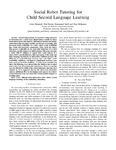Social robot tutoring for child second language learning
| dc.contributor.author | Kennedy, J | en |
| dc.contributor.author | Baxter, P | en |
| dc.contributor.author | Senft, E | en |
| dc.contributor.author | Belpaeme, T | en |
| dc.date.accessioned | 2018-08-13T14:53:10Z | |
| dc.date.available | 2018-08-13T14:53:10Z | |
| dc.date.issued | 2016-04-12 | en |
| dc.identifier.isbn | 9781467383707 | en |
| dc.identifier.uri | http://hdl.handle.net/10026.1/12111 | |
| dc.description.abstract |
An increasing amount of research is being conducted to determine how a robot tutor should behave socially in educational interactions with children. Both human-human and humanrobot interaction literature predicts an increase in learning with increased social availability of a tutor, where social availability has verbal and nonverbal components. Prior work has shown that greater availability in the nonverbal behaviour of a robot tutor has a positive impact on child learning. This paper presents a study with 67 children to explore how social aspects of a tutor robot's speech influences their perception of the robot and their language learning in an interaction. Children perceive the difference in social behaviour between 'low' and 'high' verbal availability conditions, and improve significantly between a preand a post-test in both conditions. A longer-term retention test taken the following week showed that the children had retained almost all of the information they had learnt. However, learning was not affected by which of the robot behaviours they had been exposed to. It is suggested that in this short-term interaction context, additional effort in developing social aspects of a robot's verbal behaviour may not return the desired positive impact on learning gains. | en |
| dc.format.extent | 231 - 238 | en |
| dc.language.iso | en | en |
| dc.title | Social robot tutoring for child second language learning | en |
| dc.type | Conference Contribution | |
| plymouth.volume | 2016-April | en |
| plymouth.publication-status | Published | en |
| plymouth.journal | ACM/IEEE International Conference on Human-Robot Interaction | en |
| dc.identifier.doi | 10.1109/HRI.2016.7451757 | en |
| plymouth.organisational-group | /Plymouth | |
| plymouth.organisational-group | /Plymouth/Faculty of Science and Engineering | |
| plymouth.organisational-group | /Plymouth/Research Groups | |
| plymouth.organisational-group | /Plymouth/Research Groups/Marine Institute | |
| plymouth.organisational-group | /Plymouth/Users by role | |
| dc.identifier.eissn | 2167-2148 | en |
| dc.rights.embargoperiod | Not known | en |
| rioxxterms.versionofrecord | 10.1109/HRI.2016.7451757 | en |
| rioxxterms.licenseref.uri | http://www.rioxx.net/licenses/all-rights-reserved | en |
| rioxxterms.type | Conference Paper/Proceeding/Abstract | en |


